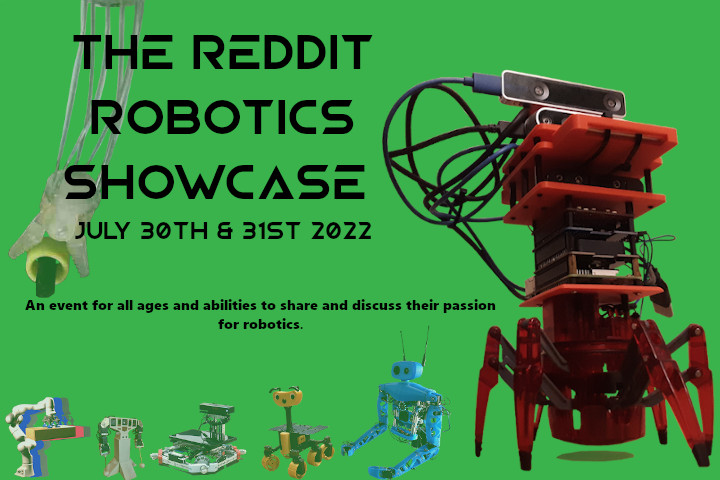Tracing the evolution of proteins back to the origin of life
How the honeybee could help protect species around the world
AlphaFold transforms biology for millions around the world
Advancing discovery of better drugs and medicine
Creating plastic-eating enzymes that could save us from pollution
AlphaFold unlocks one of the greatest puzzles in biology
Unique underwater drone a game changer for mussel and scallop industry
Accelerating the race against antibiotic resistance
A new type of soft robotic actuator that can be scaled down to just one centimeter
Accommodating Market Volumes and Staying Competitive with Scalable Sensor Solutions
r/Robotics Showcase: An event for members of all ages and abilities to share and discuss their passion for robotics

This post shows the proceedings for the 2nd annual Reddit Robotics Showcase! We’re delighted to once again offer an event for robotics enthusiasts of all ages and abilities from across the world to share their passion and their projects.
This year, we are planning an event which anticipates the enthusiasm we’ve had from our community, continuing to provide a unique opportunity for roboticists around the world to share and discuss their work, regardless of age or ability. The primary purpose of this event is to showcase the multitude of projects underway in the r/Robotics Reddit community. Topics range across all focuses of robotics, such as simulation, navigation, control, perception, and mechatronic design. We will use this showcase to present discussion pieces and foster conversation between active members in the robotics community around the world. The showcase will feature invited roboticists in research and industry to discuss what they see as technical challenges or interesting directions for robots.
The showcase is free and online, and is to be held on July 30th & 31st 2022, livestreamed via the Reddit Robotics Showcase YouTube channel. For more information, please check out the official website.
2022 Program
All times are recorded in Eastern Daylight Time (EDT), UTC-4.
Saturday, 30th of July
Session 1: Industrial and Applied Robotics
10:00 – 11:00 Matt Whelan (Ocado Technology) – The Ocado 600 Series Robot
11:00 – 11:15 Nye Mech Works (HAPPA) – Real Power Armor
11:15 – 11:30 3D Printed 6-Axis Robot Arm
11:30 – 12:00 Vasily Morzhakov (Rembrain) – Cloud Platform for Smart Robotics
12:00 – 12:15 Bridging the Gap Between Physical and Digital with BOTSZY
12:15 – 12:45 Advoard – Autonomous Fleet Robots for Logistics
Lunch Break
Session 2: Mobile Robots
14:00 – 15:00 TBC
15:00 – 15:30 Julius Sustarevas – Armstone: Autonomous Mobile 3D Printer
15:30 – 15:45 Camera Controller Hexapod & Screw/Augur All-Terrain Robot
15:45 – 16:15 Keegan Neave – NE-Five
16:15 – 16:30 Dimitar – Gravis and Ricardo
16:30 – 16:40 Kamal Carter – Aim-Hack Robot
16:40 – 16:55 Calvin – BeBOT Real Time
Sunday, 31st of July
Session 1: Bio-Inspired Robots
10:00 – 11:00 Dr. Matteo Russo (Rolls-Royce UTC in Manufacturing and On-Wing Technology) – Entering the Maze: Snake-Like Robots from Aerospace to Industry
11:00 – 11:10 Humanoid, Hexapod, and Legged Robot Control
11:10 – 11:25 Halid Yildirim – Design of a Modular Quadruped Robot Dog
11:25 – 11:35 Hexapod as Robot Pet
11:35 – 12:05 Jakub Bartoszek – Honey Badger Quadruped
12:05 – 12:20 Lutz Freitag – 01. RFC Berlin
12:20 – 12:35 Hamburg Bit-Bots
12:35 – 12:50 William Kerber – Human Mode Robotics – Lynx Quadruped and AI Training
12:50 – 13:00 Sanjeev Hegde – Juggernaut
Lunch Break
Session 2: Human Robot Interaction
14:00 – 15:00 Dr. Ruth Aylett (The National Robotarium) – Social Agents and Human Robot Interaction
15:00 – 15:30 Senmag Robotics – High Fidelity Haptics Made Accessible
15:30 – 15:40 Hand Controlled Artificial Hand
15:40 – 16:10 The Shadow Robot Company
16:10 – 16:25 Maël Abril – 6 Axis Dynamixel Robot Arm
16:25 – 16:35 Control 4WD Raspberry Pi Robot Car Using Hand Gestures
16:35 – 17:05 Tentacular – Interactive Robotic Art